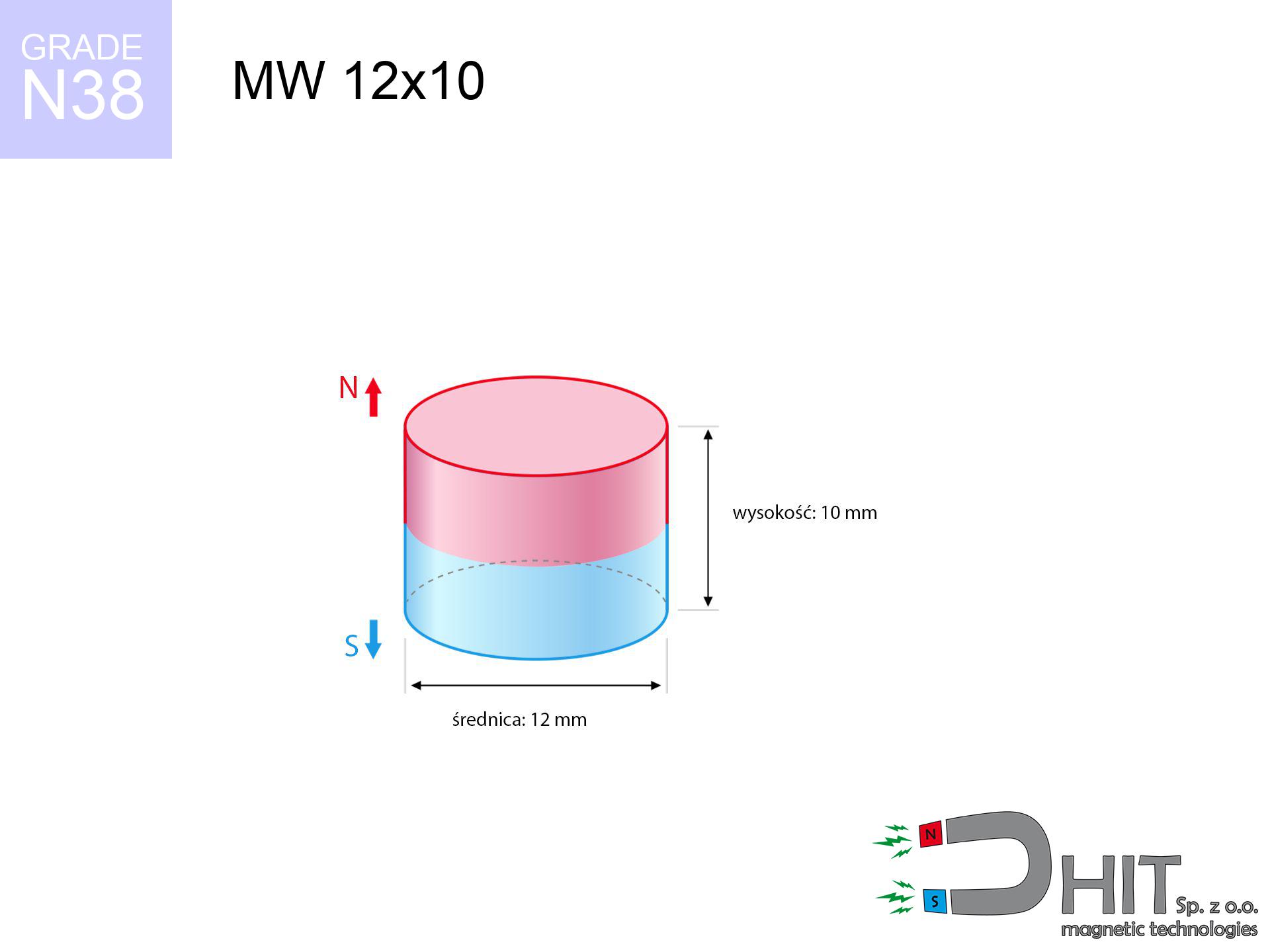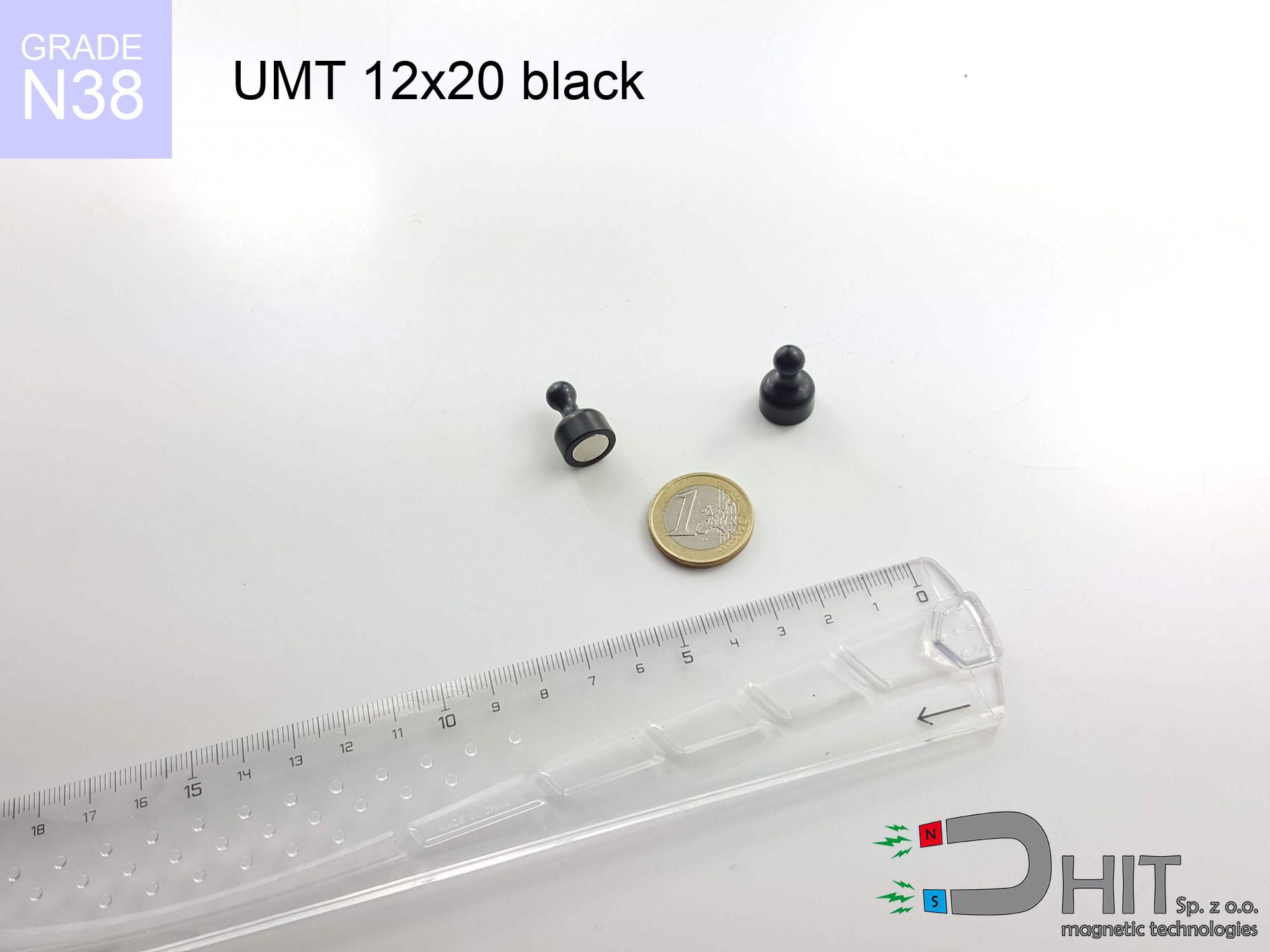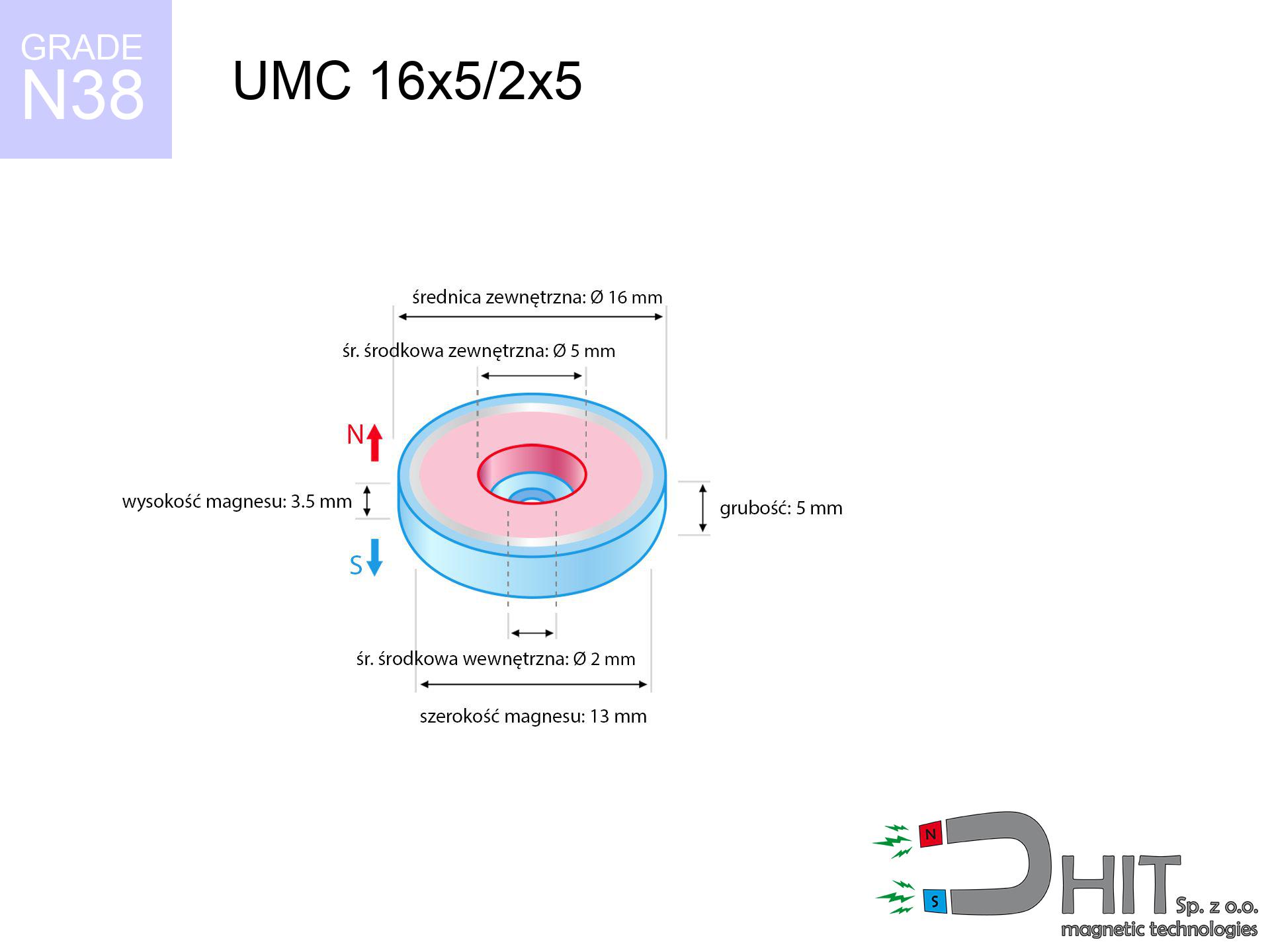MW 12x10 / N38 - cylindrical magnet
cylindrical magnet
Catalog no 010016
GTIN/EAN: 5906301810155
Diameter Ø
12 mm [±0,1 mm]
Height
10 mm [±0,1 mm]
Weight
8.48 g
Magnetization Direction
↑ axial
Load capacity
4.83 kg / 47.41 N
Magnetic Induction
531.09 mT / 5311 Gs
Coating
[NiCuNi] Nickel
3.03 ZŁ with VAT / pcs + price for transport
2.46 ZŁ net + 23% VAT / pcs
bulk discounts:
Need more?Want to negotiate?
Give us a call
+48 888 99 98 98
alternatively let us know via
inquiry form
our website.
Force along with shape of neodymium magnets can be calculated on our
magnetic calculator.
Order by 14:00 and we’ll ship today!
MW 12x10 / N38 - cylindrical magnet
Specification / characteristics MW 12x10 / N38 - cylindrical magnet
| properties | values |
|---|---|
| Cat. no. | 010016 |
| GTIN/EAN | 5906301810155 |
| Production/Distribution | Dhit sp. z o.o. |
| Country of origin | Poland / China / Germany |
| Customs code | 85059029 |
| Diameter Ø | 12 mm [±0,1 mm] |
| Height | 10 mm [±0,1 mm] |
| Weight | 8.48 g |
| Magnetization Direction | ↑ axial |
| Load capacity ~ ? | 4.83 kg / 47.41 N |
| Magnetic Induction ~ ? | 531.09 mT / 5311 Gs |
| Coating | [NiCuNi] Nickel |
| Manufacturing Tolerance | ±0.1 mm |
Magnetic properties of material N38
| properties | values | units |
|---|---|---|
| remenance Br [min. - max.] ? | 12.2-12.6 | kGs |
| remenance Br [min. - max.] ? | 1220-1260 | mT |
| coercivity bHc ? | 10.8-11.5 | kOe |
| coercivity bHc ? | 860-915 | kA/m |
| actual internal force iHc | ≥ 12 | kOe |
| actual internal force iHc | ≥ 955 | kA/m |
| energy density [min. - max.] ? | 36-38 | BH max MGOe |
| energy density [min. - max.] ? | 287-303 | BH max KJ/m |
| max. temperature ? | ≤ 80 | °C |
Physical properties of sintered neodymium magnets Nd2Fe14B at 20°C
| properties | values | units |
|---|---|---|
| Vickers hardness | ≥550 | Hv |
| Density | ≥7.4 | g/cm3 |
| Curie Temperature TC | 312 - 380 | °C |
| Curie Temperature TF | 593 - 716 | °F |
| Specific resistance | 150 | μΩ⋅cm |
| Bending strength | 250 | MPa |
| Compressive strength | 1000~1100 | MPa |
| Thermal expansion parallel (∥) to orientation (M) | (3-4) x 10-6 | °C-1 |
| Thermal expansion perpendicular (⊥) to orientation (M) | -(1-3) x 10-6 | °C-1 |
| Young's modulus | 1.7 x 104 | kg/mm² |
Physical simulation of the assembly - data
The following values represent the result of a mathematical analysis. Values are based on algorithms for the class Nd2Fe14B. Real-world conditions might slightly differ from theoretical values. Use these data as a reference point during assembly planning.
MW 12x10 / N38
| Distance (mm) | Induction (Gauss) / mT | Pull Force (kg) | Risk Status |
|---|---|---|---|
| 0 mm |
5308 Gs
530.8 mT
|
4.83 kg / 4830.0 g
47.4 N
|
strong |
| 1 mm |
4424 Gs
442.4 mT
|
3.36 kg / 3355.3 g
32.9 N
|
strong |
| 2 mm |
3585 Gs
358.5 mT
|
2.20 kg / 2203.4 g
21.6 N
|
strong |
| 3 mm |
2857 Gs
285.7 mT
|
1.40 kg / 1399.2 g
13.7 N
|
low risk |
| 5 mm |
1787 Gs
178.7 mT
|
0.55 kg / 547.8 g
5.4 N
|
low risk |
| 10 mm |
622 Gs
62.2 mT
|
0.07 kg / 66.3 g
0.7 N
|
low risk |
| 15 mm |
272 Gs
27.2 mT
|
0.01 kg / 12.7 g
0.1 N
|
low risk |
| 20 mm |
141 Gs
14.1 mT
|
0.00 kg / 3.4 g
0.0 N
|
low risk |
| 30 mm |
52 Gs
5.2 mT
|
0.00 kg / 0.5 g
0.0 N
|
low risk |
| 50 mm |
13 Gs
1.3 mT
|
0.00 kg / 0.0 g
0.0 N
|
low risk |
MW 12x10 / N38
| Distance (mm) | Friction coefficient | Pull Force (kg) |
|---|---|---|
| 0 mm | Stal (~0.2) |
0.97 kg / 966.0 g
9.5 N
|
| 1 mm | Stal (~0.2) |
0.67 kg / 672.0 g
6.6 N
|
| 2 mm | Stal (~0.2) |
0.44 kg / 440.0 g
4.3 N
|
| 3 mm | Stal (~0.2) |
0.28 kg / 280.0 g
2.7 N
|
| 5 mm | Stal (~0.2) |
0.11 kg / 110.0 g
1.1 N
|
| 10 mm | Stal (~0.2) |
0.01 kg / 14.0 g
0.1 N
|
| 15 mm | Stal (~0.2) |
0.00 kg / 2.0 g
0.0 N
|
| 20 mm | Stal (~0.2) |
0.00 kg / 0.0 g
0.0 N
|
| 30 mm | Stal (~0.2) |
0.00 kg / 0.0 g
0.0 N
|
| 50 mm | Stal (~0.2) |
0.00 kg / 0.0 g
0.0 N
|
MW 12x10 / N38
| Surface type | Friction coefficient / % Mocy | Max load (kg) |
|---|---|---|
| Raw steel |
µ = 0.3
30% Nominalnej Siły
|
1.45 kg / 1449.0 g
14.2 N
|
| Painted steel (standard) |
µ = 0.2
20% Nominalnej Siły
|
0.97 kg / 966.0 g
9.5 N
|
| Oily/slippery steel |
µ = 0.1
10% Nominalnej Siły
|
0.48 kg / 483.0 g
4.7 N
|
| Magnet with anti-slip rubber |
µ = 0.5
50% Nominalnej Siły
|
2.42 kg / 2415.0 g
23.7 N
|
MW 12x10 / N38
| Steel thickness (mm) | % power | Real pull force (kg) |
|---|---|---|
| 0.5 mm |
|
0.48 kg / 483.0 g
4.7 N
|
| 1 mm |
|
1.21 kg / 1207.5 g
11.8 N
|
| 2 mm |
|
2.42 kg / 2415.0 g
23.7 N
|
| 5 mm |
|
4.83 kg / 4830.0 g
47.4 N
|
| 10 mm |
|
4.83 kg / 4830.0 g
47.4 N
|
MW 12x10 / N38
| Ambient temp. (°C) | Power loss | Remaining pull | Status |
|---|---|---|---|
| 20 °C | 0.0% |
4.83 kg / 4830.0 g
47.4 N
|
OK |
| 40 °C | -2.2% |
4.72 kg / 4723.7 g
46.3 N
|
OK |
| 60 °C | -4.4% |
4.62 kg / 4617.5 g
45.3 N
|
OK |
| 80 °C | -6.6% |
4.51 kg / 4511.2 g
44.3 N
|
|
| 100 °C | -28.8% |
3.44 kg / 3439.0 g
33.7 N
|
MW 12x10 / N38
| Gap (mm) | Attraction (kg) (N-S) | Repulsion (kg) (N-N) |
|---|---|---|
| 0 mm |
19.64 kg / 19641 g
192.7 N
5 928 Gs
|
N/A |
| 1 mm |
16.52 kg / 16525 g
162.1 N
9 736 Gs
|
14.87 kg / 14872 g
145.9 N
~0 Gs
|
| 2 mm |
13.64 kg / 13644 g
133.9 N
8 847 Gs
|
12.28 kg / 12280 g
120.5 N
~0 Gs
|
| 3 mm |
11.12 kg / 11118 g
109.1 N
7 986 Gs
|
10.01 kg / 10006 g
98.2 N
~0 Gs
|
| 5 mm |
7.16 kg / 7161 g
70.3 N
6 410 Gs
|
6.45 kg / 6445 g
63.2 N
~0 Gs
|
| 10 mm |
2.23 kg / 2228 g
21.9 N
3 575 Gs
|
2.00 kg / 2005 g
19.7 N
~0 Gs
|
| 20 mm |
0.27 kg / 270 g
2.6 N
1 244 Gs
|
0.24 kg / 243 g
2.4 N
~0 Gs
|
| 50 mm |
0.00 kg / 5 g
0.0 N
164 Gs
|
0.00 kg / 0 g
0.0 N
~0 Gs
|
MW 12x10 / N38
| Object / Device | Limit (Gauss) / mT | Safe distance |
|---|---|---|
| Pacemaker | 5 Gs (0.5 mT) | 7.5 cm |
| Hearing aid | 10 Gs (1.0 mT) | 6.0 cm |
| Timepiece | 20 Gs (2.0 mT) | 4.5 cm |
| Mobile device | 40 Gs (4.0 mT) | 3.5 cm |
| Car key | 50 Gs (5.0 mT) | 3.5 cm |
| Payment card | 400 Gs (40.0 mT) | 1.5 cm |
| HDD hard drive | 600 Gs (60.0 mT) | 1.5 cm |
MW 12x10 / N38
| Start from (mm) | Speed (km/h) | Energy (J) | Predicted outcome |
|---|---|---|---|
| 10 mm |
24.27 km/h
(6.74 m/s)
|
0.19 J | |
| 30 mm |
41.69 km/h
(11.58 m/s)
|
0.57 J | |
| 50 mm |
53.82 km/h
(14.95 m/s)
|
0.95 J | |
| 100 mm |
76.11 km/h
(21.14 m/s)
|
1.90 J |
MW 12x10 / N38
| Technical parameter | Value / Description |
|---|---|
| Coating type | [NiCuNi] Nickel |
| Layer structure | Nickel - Copper - Nickel |
| Layer thickness | 10-20 µm |
| Salt spray test (SST) ? | 24 h |
| Recommended environment | Indoors only (dry) |
MW 12x10 / N38
| Parameter | Value | SI Unit / Description |
|---|---|---|
| Magnetic Flux | 6 105 Mx | 61.1 µWb |
| Pc Coefficient | 0.81 | High (Stable) |
MW 12x10 / N38
| Environment | Effective steel pull | Effect |
|---|---|---|
| Air (land) | 4.83 kg | Standard |
| Water (riverbed) |
5.53 kg
(+0.70 kg Buoyancy gain)
|
+14.5% |
1. Wall mount (shear)
*Caution: On a vertical surface, the magnet retains merely approx. 20-30% of its max power.
2. Efficiency vs thickness
*Thin steel (e.g. 0.5mm PC case) severely weakens the holding force.
3. Power loss vs temp
*For N38 material, the critical limit is 80°C.
4. Demagnetization curve and operating point (B-H)
chart generated for the permeance coefficient Pc (Permeance Coefficient) = 0.81
This simulation demonstrates the magnetic stability of the selected magnet under specific geometric conditions. The solid red line represents the demagnetization curve (material potential), while the dashed blue line is the load line based on the magnet's geometry. The Pc (Permeance Coefficient), also known as the load line slope, is a dimensionless value that describes the relationship between the magnet's shape and its magnetic stability. The intersection of these two lines (the black dot) is the operating point — it determines the actual magnetic flux density generated by the magnet in this specific configuration. A higher Pc value means the magnet is more 'slender' (tall relative to its area), resulting in a higher operating point and better resistance to irreversible demagnetization caused by external fields or temperature. A value of 0.42 is relatively low (typical for flat magnets), meaning the operating point is closer to the 'knee' of the curve — caution is advised when operating at temperatures near the maximum limit to avoid strength loss.
Elemental analysis
| iron (Fe) | 64% – 68% |
| neodymium (Nd) | 29% – 32% |
| boron (B) | 1.1% – 1.2% |
| dysprosium (Dy) | 0.5% – 2.0% |
| coating (Ni-Cu-Ni) | < 0.05% |
Environmental data
| recyclability (EoL) | 100% |
| recycled raw materials | ~10% (pre-cons) |
| carbon footprint | low / zredukowany |
| waste code (EWC) | 16 02 16 |
See also deals
Advantages and disadvantages of rare earth magnets.
Advantages
- Their power remains stable, and after around 10 years it drops only by ~1% (theoretically),
- Neodymium magnets are highly resistant to demagnetization caused by external interference,
- In other words, due to the shiny layer of silver, the element gains visual value,
- They feature high magnetic induction at the operating surface, which improves attraction properties,
- Due to their durability and thermal resistance, neodymium magnets are capable of operate (depending on the form) even at high temperatures reaching 230°C or more...
- Possibility of precise machining and optimizing to complex needs,
- Significant place in future technologies – they are used in data components, drive modules, precision medical tools, and other advanced devices.
- Thanks to efficiency per cm³, small magnets offer high operating force, with minimal size,
Weaknesses
- To avoid cracks upon strong impacts, we suggest using special steel holders. Such a solution secures the magnet and simultaneously improves its durability.
- Neodymium magnets lose their power under the influence of heating. As soon as 80°C is exceeded, many of them start losing their power. Therefore, we recommend our special magnets marked [AH], which maintain stability even at temperatures up to 230°C
- Due to the susceptibility of magnets to corrosion in a humid environment, we suggest using waterproof magnets made of rubber, plastic or other material immune to moisture, when using outdoors
- Limited possibility of creating nuts in the magnet and complex forms - recommended is cover - mounting mechanism.
- Potential hazard related to microscopic parts of magnets are risky, in case of ingestion, which becomes key in the aspect of protecting the youngest. Additionally, small elements of these magnets are able to disrupt the diagnostic process medical when they are in the body.
- With large orders the cost of neodymium magnets is economically unviable,
Holding force characteristics
Maximum holding power of the magnet – what contributes to it?
- with the use of a sheet made of low-carbon steel, guaranteeing full magnetic saturation
- whose thickness reaches at least 10 mm
- with a surface cleaned and smooth
- with direct contact (without coatings)
- during detachment in a direction perpendicular to the mounting surface
- at room temperature
Impact of factors on magnetic holding capacity in practice
- Air gap (betwixt the magnet and the plate), since even a very small distance (e.g. 0.5 mm) leads to a drastic drop in lifting capacity by up to 50% (this also applies to varnish, rust or dirt).
- Pull-off angle – note that the magnet has greatest strength perpendicularly. Under shear forces, the holding force drops significantly, often to levels of 20-30% of the nominal value.
- Metal thickness – the thinner the sheet, the weaker the hold. Part of the magnetic field passes through the material instead of converting into lifting capacity.
- Steel type – low-carbon steel attracts best. Alloy admixtures lower magnetic properties and lifting capacity.
- Base smoothness – the more even the plate, the better the adhesion and stronger the hold. Unevenness acts like micro-gaps.
- Thermal conditions – NdFeB sinters have a sensitivity to temperature. At higher temperatures they are weaker, and at low temperatures they can be stronger (up to a certain limit).
Lifting capacity testing was carried out on plates with a smooth surface of optimal thickness, under a perpendicular pulling force, whereas under shearing force the lifting capacity is smaller. Moreover, even a slight gap between the magnet’s surface and the plate reduces the lifting capacity.
Threat to navigation
Remember: neodymium magnets generate a field that disrupts precision electronics. Keep a safe distance from your phone, device, and GPS.
Avoid contact if allergic
Certain individuals have a sensitization to nickel, which is the typical protective layer for NdFeB magnets. Extended handling might lead to dermatitis. It is best to use protective gloves.
Do not underestimate power
Be careful. Rare earth magnets act from a distance and snap with huge force, often quicker than you can move away.
Do not drill into magnets
Powder generated during machining of magnets is combustible. Do not drill into magnets without proper cooling and knowledge.
Thermal limits
Keep cool. NdFeB magnets are sensitive to heat. If you need resistance above 80°C, look for special high-temperature series (H, SH, UH).
Pinching danger
Big blocks can break fingers in a fraction of a second. Never place your hand betwixt two attracting surfaces.
No play value
NdFeB magnets are not toys. Accidental ingestion of multiple magnets can lead to them pinching intestinal walls, which poses a severe health hazard and necessitates urgent medical intervention.
Health Danger
Individuals with a heart stimulator should keep an absolute distance from magnets. The magnetic field can interfere with the operation of the life-saving device.
Cards and drives
Data protection: Strong magnets can damage data carriers and delicate electronics (heart implants, medical aids, mechanical watches).
Fragile material
Despite metallic appearance, the material is brittle and cannot withstand shocks. Avoid impacts, as the magnet may crumble into sharp, dangerous pieces.









